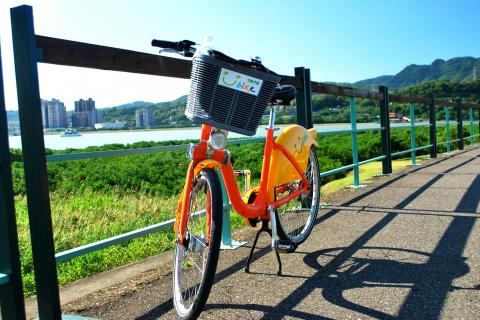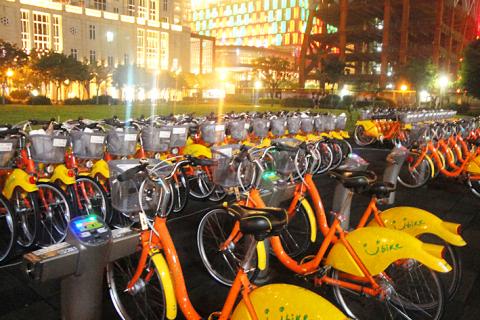Walking into bowels of Taipei’s Mass Rapid Transit system for the first time can be a bewildering experience. The same can be said about the Taipei City Government’s highly ambitious Youbike bicycle sharing system. But once you’ve signed up, used the service once or twice and figured out where the stations are, Youbike is a breeze.
Since Youbike stations are popping up all over the city, the Taipei Times wanted to get some feedback from users. There are two ways to get started with Youbike — EasyCard or credit card. If you already have an EasyCard, simply go to the Web site (www.youbike.com.tw/home.php) and click on the member icon. After following the instructions in English or Chinese, an SMS is sent to your mobile phone for confirmation and you can head directly to any of the stations to use a Youbike. The first 30 minutes of every rental are free and every 30 minutes after that is NT$10.
On the road

Photos: Marcus Aurelius and Lindsey Leamen
Using a credit card should be even easier, since all riders have to do is go to a Youbike kiosk and flash the credit card (as long as it has a microchip) and pick a bicycle. However, the credit card service is only available at 31 out of the 41 stations (mostly in the Xinyi District, 信義), and this is only marked on the physical map, not the one on the Youbike Web site.
Kate Lin (林雅婷) learned about Youbike from her co-worker and now uses the service at least twice a week.
“I enjoy doing this because I don’t get much chance to exercise during the week,” Lin said. “Also, there’s only one bus I can take home, and sometimes I have to wait a long time for it. Riding Youbike [home from work] is faster than that.”

Photo: Marcus Aurelius and Lindsey Leamen
Lin isn’t completely satisfied, though. “The registration machine at the station nearest my house is always broken,” she said. “Also, one time I couldn’t find any vacant places to return the bike, so I could only wait there until someone came to rent another bike.”
Lindsey Leamen, who prefers using the bikes for longer trips, thinks the service could be improved by adding more stations in places that aren’t in the main areas of the city.
“I work in Neihu and would love to have the option of biking to work in nice weather, and then taking the MRT home if the weather turns bad, which is a common occurrence in Taipei.”
Convenient service
Overall, Leamen believes the service is convenient because it provides a list of stations, a real time listing of how many bikes are there at that particular time and how many empty spaces are available.
“The first time I used a bike, I borrowed it for three and a half hours and it only cost me NT$60. That’s amazing, especially considering there’s a similar bike share program in Toronto and for half the time I ended up getting charged the equivalent of NT$700. Oh, and I love the baskets!”
Alex Trup, an avid Youbike rider, thinks it has a lot of potential. “It is very well-priced and if you are a light user, you will rarely pay anything,” he said. “I even made it once from Taipei City Hall to Academia Sinica in Nangang within the free time.”
Youbike hasn’t expanded to where Trup lives yet, but he still believes the service will improve. “Taipei is a great city for cycling because it has plenty of paths, generally flat terrain, and on some days, gorgeous weather. YouBike will solidify Taipei’s position as one of the world’s greatest cities for cycling.”

In Taiwan there are two economies: the shiny high tech export economy epitomized by Taiwan Semiconductor Manufacturing Co (TSMC, 台積電) and its outsized effect on global supply chains, and the domestic economy, driven by construction and powered by flows of gravel, sand and government contracts. The latter supports the former: we can have an economy without TSMC, but we can’t have one without construction. The labor shortage has heavily impacted public construction in Taiwan. For example, the first phase of the MRT Wanda Line in Taipei, originally slated for next year, has been pushed back to 2027. The government

July 22 to July 28 The Love River’s (愛河) four-decade run as the host of Kaohsiung’s annual dragon boat races came to an abrupt end in 1971 — the once pristine waterway had become too polluted. The 1970 event was infamous for the putrid stench permeating the air, exacerbated by contestants splashing water and sludge onto the shore and even the onlookers. The relocation of the festivities officially marked the “death” of the river, whose condition had rapidly deteriorated during the previous decade. The myriad factories upstream were only partly to blame; as Kaohsiung’s population boomed in the 1960s, all household

Allegations of corruption against three heavyweight politicians from the three major parties are big in the news now. On Wednesday, prosecutors indicted Hsinchu County Commissioner Yang Wen-ke (楊文科) of the Chinese Nationalist Party (KMT), a judgment is expected this week in the case involving Hsinchu Mayor Ann Kao (高虹安) of the Taiwan People’s Party (TPP) and former deputy premier and Taoyuan Mayor Cheng Wen-tsan (鄭文燦) of the Democratic Progressive Party (DPP) is being held incommunicado in prison. Unlike the other two cases, Cheng’s case has generated considerable speculation, rumors, suspicions and conspiracy theories from both the pan-blue and pan-green camps.

Stepping inside Waley Art (水谷藝術) in Taipei’s historic Wanhua District (萬華區) one leaves the motorcycle growl and air-conditioner purr of the street and enters a very different sonic realm. Speakers hiss, machines whir and objects chime from all five floors of the shophouse-turned- contemporary art gallery (including the basement). “It’s a bit of a metaphor, the stacking of gallery floors is like the layering of sounds,” observes Australian conceptual artist Samuel Beilby, whose audio installation HZ & Machinic Paragenesis occupies the ground floor of the gallery space. He’s not wrong. Put ‘em in a Box (我們把它都裝在一個盒子裡), which runs until Aug. 18, invites